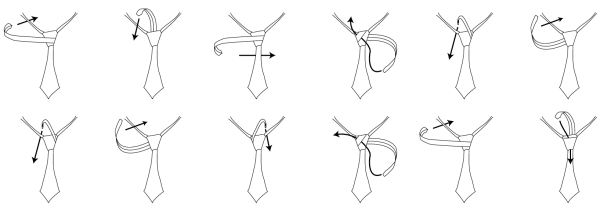Novel knot news now! You might already be aware that there are 85 ways to tie a tie. Well, cast that preconception aside because there are actually loads.
A few people noticed that in The Matrix Reloaded, one of the characters has a pretty classy tie knotted so that the front isn’t just a flat bit of fabric. That breaks one of the assumptions made by Fink and Mao in their seminal paper Tie knots, random walks and topology where they generated 85 different knots, only paying attention to their forwards-facing shape.
Mikael Vejdemo-Johansson (you might recognise him as @michiexile) and chums set about working out how many more kinds of knots you can tie, if you let the front get complicated. Fink and Mao noticed you can express a set of instructions to tie a knot as a string in a formal language; with the new relaxed set of rules the authors proved that the language of tie knot instructions is either context-free (recognised by a finite state automaton with a stack) or context-sensitive (recognised by a linear bounded automaton).
Those are pretty complicated, so the authors restricted themselves to a sublanguage covering the kinds of knots seen in The Matrix Reloaded which is regular (recognised by a finite state automaton) and hence much easier to work with. From there, a little bit of combinatorics and some consideration of the physical realities of ties gets you the fact that there are 177,147 ways to tie a tie. Of course, if someone decides to start tying their tie in a new way, there’ll be even more.
A fun paper titled More ties than we thought gives all the working-out, and Mikael has also set up a random tie knot generator so you can try the theory out yourself.
More information
More ties than we thought by Dan Hirsch, Meredith L Patterson, Anders Sandberg, Mikael Vejdemo-Johansson
Tie knots, random walks and topology by Thomas Fink and Yong Mao
Designing tie knots by random walks by Thomas Fink and Yong Mao
The 85 Ways to Tie a Tie, Fink and Mao’s book about their papers
